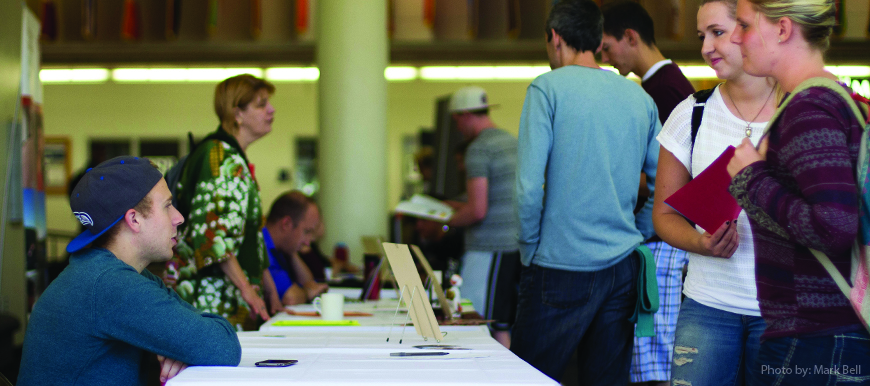Aggies discuss cost and benefits of study abroad
“When students talk to students, that’s when it clicks,” said Kay Forsyth, the program director for study abroad at Utah State University.
The Utah State Office of Global Engagement hosted its fall study abroad fair on Wednesday in the Taggart Student Center Sunburst Lounge. The event focused on presenting the wide variety of study abroad programs available to Aggies in the coming semesters.
Forsyth said the fair was a chance to get students excited about Study Abroad possibilities at the start of the semester, while providing students an opportunity to meet faculty members and program providers. Students also had the opportunity to talk with other students who recently returned from study abroad programs.
Though students often show high interest in study abroad near the beginning of the semester, that number decreases rapidly, said Madeline Greenlick , a study abroad adviser .
“When I talk to Connections classes before the semester begins, I’d say the majority of students have heard of study abroad and say they would want to do a study abroad,” Greenlick said. “It’s hard to say what changes from the time of thinking of a study abroad to actually applying.”
Greenlick said on average only 300 to 400 students — roughly 1 percent of the USU population in Logan — participate in study abroad programs every year. Greenlick, who has been working in the study abroad office since 2007, said she believes much of this loss comes from financial fears.
But this fear of financial impediment can be deluded, said Katie Davidson, another adviser of the Office of Global Engagement.
“It is really affordable here,” Davidson said. “That’s kind of a myth, that people think study abroad is expensive.”
According to Forsyth, the USU study abroad office recently partnered up with Generation Study Abroad. This program, which runs under the Institute of International Education, was created to increase opportunities for students to study abroad. The IEE website claims only 10 percent of U.S. students study abroad every year, and the program has a goal of helping universities across the nation to double that number in the next five years — a goal which USU has adopted as well.
“It’s an ambitious goal,” Forsyth said. “President Albrecht is in support of this initiative, and there has been reach out to deans and department heads to get everybody on board.”
Greenlick noted that Utah State offers a relatively low tuition cost in comparison with other similarly ranked universities, which makes studying abroad more affordable.
But Tori Fica is still paying off student loans for a study abroad she did in France in 2013.
“I really don’t care,” Fica said. “Compared to my graduate school debt, what I paid to go and study abroad really wasn’t that much.”
Fica did say she was doubtful at first whether or not the the experience would be worth her money.
“I was the least prepared, financially, that anyone could ever be for a study abroad,” Fica said. “But I have never for a second regretted it.”
Another Aggie, Claire Hubbard, said her semester-long study abroad in Italy was well-worth the cost.
“It is so comparable to USU’s tuition, and that’s including food and housing,” Hubbard said. “So really, if you can get the plane ticket, you can study abroad.”
Hubbard estimated only a $2,000 increase in expenses of her study abroad compared to what she pays to live in Logan and attend USU for a semester.
Hubbard had the benefit of free airfare due to family connections and agreed that it made a difference for her.
“I would say that is probably the most expensive part of it,” Hubbard said.
Greenlick said she feels more students would participate in study abroad programs if they knew more details about the programs.
“I think it’s just getting the word out about the affordability,” she said.
Regardless of the cost, Fica and Hubbard believe study abroad programs are worth the cash.
“I definitely learned lessons I couldn’t have learned any other way,” Fica said. “Not everything can be measured with money.”
For more information on USU study abroad opportunities visit globalengagement.usu.edu.

